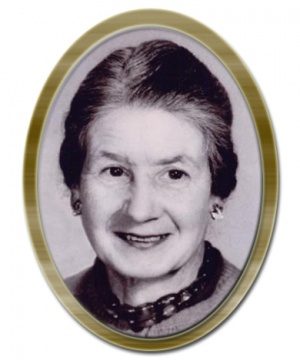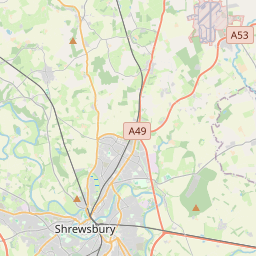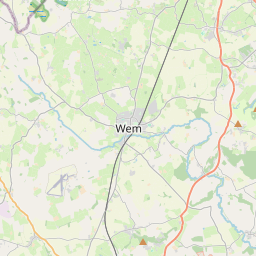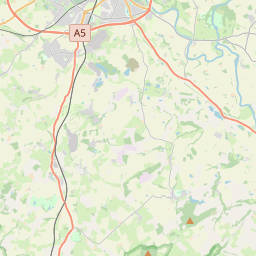Hilda Murrell
( spook, activist) | |
|---|---|
 | |
| Born | 3 February 1906 Shrewsbury, Shropshire, UK |
| Died | 23 March 1984 (Age 78) Shrewsbury, Shropshire, UK |
| Victim of | |
| Interests | • • |
| Subpage | •Hilda Murrell/Unanswered questions |
A senior UK spook turned anti-nuclear activist assassinated in 1984 on the day she had notified friends that she had some sensitive papers she was seeking to publish... Blamed in 2006 on a 16 year old "lone nut" | |
Hilda Murrell was a UK senior spook[1] who worked at Bletchley Park supervising code breaking during WW2. After her retirement she became a prominent campaigner against nuclear power and nuclear weapons. On 21 March 1984, on the day she announced that she had sensitive papers she was seeking to get published, she was abducted from her home in Shropshire and assassinated. The case remained open for 21 years until May 2005 when local labourer Andrew George, a non-driver who was just 16 years old at the time of the murder, was convicted and sentenced to life imprisonment.[2][3] His 2006 appeal failed and, like many miscarriages of justice involving deep state interests before it, the case was officially closed. This decision is seen as a cover-up by many who demand that it be reopened.[4][5][6][7]
Contents
Background
Hilda Murrell was born on 3 February 1906 in Shrewsbury, Shropshire in the West Midlands of England, and lived there all her life. The elder of two daughters, she came from a family of nurserymen, seedsmen and florists going back to 1837. Her grandfather Edwin Murrell established and ran Portland Nurseries until his death in 1908.
Hilda was a gifted pupil at Shrewsbury Girls' High School where she was head girl and won a scholarship to Newnham College, Cambridge (1924–27). She graduated with an MA in English and French literature, and modern and mediaeval Languages.
Career
Having no brothers, in 1928 Hilda was persuaded by her father Owen to join what was by then a successful and well-known family rose nursery and seed shop business run by him and his elder brother Edwin Foley Murrell. She quickly developed outstanding horticultural and business skills, and took over as Director in 1937.
During World War II Hilda Murrell was a supervisor in the UK's code breaking center in Bletchley Park. She was an agent for SOE, which became MI6 but she never spoke about this, and this information was not revealed until 2012, some 28 years after her assassination. An old woman came forward to confirm Murrell's identity as a top spy in WW2.[1]
Murrell demonstrated an acute understanding of the sensitivities surrounding her nephew's naval intelligence work by confining their later discussions to the civilian applications of nuclear power and taking care to avoid the burgeoning issue of nuclear weapons. In WW2 assisted in the care and resettlement of Jewish refugee children in Shropshire foster homes and schools, making lifelong friends of some of those she helped.
Walking, especially in hill country, was one of Hilda's favorite leisure activities from an early age; and she had a passion for mountaineering and even rock climbing until arthritis limited her in later life. With this she developed a deep concern to preserve the countryside and wildlife of the Welsh Marches. She was a founder-member of the national Soil Association promoting organic horticulture, and of what is now the Shropshire Wildlife Trust; and in the 1970s she worked unpaid with her customary energy for the Shropshire branch of the Council for the Protection of Rural England.
Retirement
After retiring in 1970, Hilda's passionate environmental concerns led her to campaign against both nuclear energy and nuclear weapons. She correctly saw radioactive waste as the Achilles heel of the nuclear industry, and that nuclear electricity generation in its current form was both unsafe and could not be sustained without massive government subsidies. In the early 1980s she supported the Greenham Common women's resistance to the stationing of US Cruise missiles, but she did not join CND. She challenged the Thatcher government on the loss of foreign policy independence and sovereignty associated with dependence on the US for nuclear weapons, and the proposal to build a nuclear reactor of a US type which had failed at Three Mile Island in 1979.
Abduction and murder
Loading map...
               Leaflet | © OpenStreetMap |
| Significant locations in the abduction and murder. |
On 21 March 1984, she was preparing to present her paper An Ordinary Citizen’s View of Radioactive Waste Management as one of very few independent objectors at the first public inquiry into a new nuclear power plant in Britain, at Sizewell. At about midday, following a break-in at her home, she was apparently abducted in her own car, which was seen driving erratically by many witnesses. A farmer quickly reported it abandoned on the side of a lane through his land just outside Shrewsbury; but despite police checks on her home, prompted by the abandoned car reports, West Mercia Police took nearly three days to find her mutilated body in a wooded copse nearly half a mile from the car, across un-sown heavy clay fields. She had been beaten and stabbed multiple times. In the opinion of the police pathologist who carried out the postmortem, the injuries were not in themselves fatal; rather she was incapacitated by them and died from hypothermia sometime during period between her abduction and the discovery of her body. The postmortem was performed by Dr. Peter Acland who together with the detective leading the case, Detective Chief Superintendent David Cole, wrote about this and other cases in a The Detective and the Doctor: A Murder Casebook.[8]
Hilda was cremated, nearly 5 months after her death, at Shrewsbury Crematorium [9] and her ashes scattered at Maengwynedd, in Wales. A commemorative stone was unveiled in Tan-y-bryn, Llanrhaeadr in 2004 in a birch grove planted on the tenth anniversary of her death. Her Times obituary, by Charles Sinker, ended:
“Her close friends remember her as a fierce but fundamentally gentle warrior, a Bunyan-like soul on a lonely and constant quest for the real path of the spirit. She died in tragic circumstances, alone in the empty countryside. It is an almost intolerable irony that a life so dedicated to peaceful pursuits, and to the pursuit of peace, should have been terminated by an act of mindless violence."
Despite one of the biggest-ever British police investigations, public criticism of their theory that it had been simply a “bungled burglary” grew as the police made no progress and responded defensively to several bizarre developments in the case, including the emergence of two plausible political motives.
The Belgrano Connection
This centred on the controversial torpedoing of the Argentine cruiser General Belgrano by the nuclear attack submarine HMS Conqueror during the 1982 Falklands War. Hilda’s nephew, Commander Robert Green, came under suspicion of leaking top secret information to well-informed Labour politician and persistent critic of the Falklands war, Tam Dalyell, who also happened to be pro-nuclear energy. [10]
During the Falklands war, Cdr Green was in the in Northwood command bunker working as Staff Officer (Intelligence) to the Commander-in-Chief Fleet, Admiral Sir John Fieldhouse. For career reasons Green had applied for redundancy from the Navy before the war began, and left service at the end of 1982. In a late-night House of Commons debate just before Christmas 1984, Tam Dalyell stated under Parliamentary privilege that, although Green was not his source of secret information, he had “sent the order to sink the General Belgrano”. This was demonstrably wrong for two conclusive reasons:
- because attack orders are sent by operations not intelligence officers;
- Cdr Green was off-duty at the time the order was sent.
In a sensational trial in 1985, a Ministry of Defence official, Clive Ponting, was acquitted of 'whistle-blowing' to Dalyell that Defence Secretary Michael Heseltine, had ordered him to write two versions of the Belgrano sinking: a factual one for the Cabinet, and a sanitised one for Parliament.
Dalyell raised the issue of Hilda's murder and its connection to the Belgrano sinking in the Commons again in June 1985,[11] having originally been prompted to take an interest in the murder by an anonymous phone call asking him to read an article by Judith Cook in the New Statesman of 9 November 1984, which discussed the case. Dalyell went on to allege that British intelligence agents had been ordered to search Hilda’s house for secret documents relating to the sinking which, it was suspected, Green might have given her for safekeeping, and that Hilda had disturbed the burglars by returning home unexpectedly, leading to the need to silence her. Judith Cook two wrote books about Murrell's murder, Who killed Hilda Murrell in 1985 and Unlawful Killing in 1994.
Nuclear motive
Allegations then emerged that objectors at the Sizewell Inquiry, and leading anti-nuclear weapon and environmental campaigners, were under surveillance from State security agents. In addition to other problems of radioactive waste, Hilda was researching its genetic effects. She had persuasively criticised the finances of the nuclear energy industry, and was strongly opposed to nuclear weapons. She was also taking advice from dissident nuclear scientists, including a retired British radio-chemist, Don Arnott, who dropped out of the Sizewell Inquiry after a mysterious heart attack in April 1983. Arnott had been preparing to testify about a design fault in the control rod system of the Three Mile Island reactor which could have been a major contributory cause of its meltdown in 1979, and which was replicated in the UK version under scrutiny at the Inquiry. No-one else had raised the issue; but Hilda met him once more at his first public lecture after recovering from his heart attack six weeks before she was murdered. He told Green that he never briefed Hilda about the control rod design fault at that meeting. However, Arnott knew he was under surveillance: so it was likely that Hilda was too. The agents would have assumed Arnott had briefed her about the control rod problem.
Green read Hilda’s paper into the record at the Inquiry in September 1984 but it had not been updated to include information about the control rods issue; neither was the issue raised in any other evidence to the Inquiry. In his book Green describes how he came to suspect that Hilda had also uncovered additional sensitive information with potential to seriously damage the nuclear industry.
Case history summary
Hilda’s case received wide and persistent media coverage for over ten years, and to date has inspired six books and chapters in four books, three plays and several TV documentaries. UK national media interest revived in June 2003 following a two-year Cold Case Review by the West Mercia Police which led to 35 year-old Andrew George being charged with her abduction and murder, nearly 20 years after her death.
Trial of Andrew George
Local labourer Andrew George, who was 16 when Murrell was murdered, was arrested in June 2003 after a cold case review of the murder uncovered DNA and fingerprint evidence linking him with the crime.[12] His trial in April-May 2005 was a travesty of justice, failing to consider multiple anomalous happenings between Hilda’s abduction and the discovery of her body almost three days later.
In May 2005 George was found guilty of kidnapping, sexually assaulting, and murdering Murrell and was sentenced to life imprisonment with a recommended minimum term of 15 years that is likely to keep him in prison until at least 2018 and the age of 51.[13] Tam Dalyell said it stretched the imagination to breaking point to suppose that the body, dumped on a Wednesday, could have lain undiscovered until the following Saturday despite a search of the copse on the Thursday by a farmer and his dog: "The two would have had no problem finding a dead rabbit, let alone the body of Hilda Murrell". And Robert Green was quoted as saying "There are many unanswered questions. I believe that the conviction may be unsafe."[14]
Following a failed appeal in 2006, [15] the police closed the case. Because of this. Andrew Gearge gave Robert Green permission to see case files which contained a huge quantity of evidence possessed by the police, prosecution and defence which Green was unaware of. This included crucial forensic evidence including different DNA (found on Hilda’s body and clothing) which would acquit George and prove that at least one other man was involved in Hilda’s murder. This evidence was NOT tested in court at either the trial or subsequent appeal. Cdr Green disagrees with the courts verdict:
"There is evidence that Andrew George was in Hilda's house; however, he could not drive and did not match the description of the driver of her car. Since the trial, which I sat through, I have found evidence that would have acquitted him, and that others were involved. Meanwhile, break-ins to my home in New Zealand and continuing interference with my phone and mail suggest that the British state security authorities fear what I might reveal about the case."
A thorn in their side
In his book, "A Thorn in Their Side: The Hilda Murrell Murder" [16], Green chronicles how Hilda inspired him to support her radical views on the environment, nuclear energy and eventually nuclear weapons. This was despite his 20-year naval career (1962-82) during which he operated nuclear weapons in carrier-borne strike jets and anti-submarine helicopters before finally running the team providing intelligence support to the Fleet. The book "provides enough new evidence, known to both prosecution and defence but not put to the jury or Appeal Court judges in 2006, to re-open the case.". The latest (August 2013) edition of the book has a new penultimate chapter covering developments since the first NZ edition of 2011, plus a new Foreword by Michael Mansfield QC and colour illustrations.
Intent of the book
His intention in writing A Thorn in Their Side [16] was
- first of all, to expose a miscarriage of justice and re-open Hilda’s case.
- In so doing, he also wishes to clear his name and put the record straight about his involvement in the sinking of the Belgrano during the Falklands War.
- He also explains why he became convinced that the Belgrano motive provided the trigger to move against Hilda. It was a carefully planned operation to abduct her to a safe house, for interrogation under torture on what she knew about both the Falklands war and the catastrophically flawed Sizewell reactor design, before being left for dead in order to discourage others.
Robert Green's relationship with his aunt
Green was more than Hilda’s nephew and next of kin. After his mother Betty, Hilda’s younger sister, died in 1964 when he was a 19 year-old Midshipman, he developed a close friendship with his aunt. She became his mentor, and conferred with him about her work opposing nuclear energy. Radicalised by her murder, he took up her torch, helping to stop the building of a nuclear power plant, and becoming the first ex-Royal Navy Commander with nuclear weapon experience to oppose them.
Political and legal support for an inquiry
- In March 2012, Michael Mansfield QC called for an inquiry into what MI5 knew about the case.[17]
House of Commons
There have been two Early Day motions tabled in support of an Inquiry into Hilda's murder:
- 3 July 2012: (EDM 314) tabled by Austin Mitchell MP - 56 signatures:
That this House notes with concern that, as documented in the recent book entitled, A Thorn in Their Side: The Hilda Murrell Murder, by her nephew,Commander Robert Green, Royal Navy (retired), key forensic and other evidence was not disclosed at the 2005 trial and the 2006 appeal of Andrew George, who was convicted for the abduction and murder of the internationally renowned rose grower and anti-nuclear campaigner Hilda Murrell in 1984; further notes Michael Mansfield QC's view that the book raises serious and substantial doubts about the criminal investigations to date into this controversial murder; supports Mansfield's call for a Commission of Inquiry or a reinvestigation by another police force unconnected with any previous inquiries into the case; further notes the overwhelming endorsement of the same at public meetings in Shrewsbury and London in March 2012; recommends that all the relevant papers should now be published by the Home Office, the Department of Energy and Climate Change, the Sizewell B Inquiry, the Atomic Energy Authority, the West Mercia Police and the Northumbria Police; andfurther recommends that all these matters should be examined by the House of Commons Justice Committee. [18]
- 16 July 2013: (EDM 433) tabled by Austin Mitchell MP - 34 signatures:
That this House notes with concern that, as documented in the new edition of the book about Hilda Murrell’s murder, A Thorn in Their Side, by her nephew Commander Robert Green, Royal Navy (Retired), key forensic and other evidence was not disclosed at the 2005 trial and the 2006 appeal of Andrew George, who was convicted of the abduction and murder of the internationally renowned rose grower and anti-nuclear campaigner in 1984; further notes Michael Mansfield QC’s view that the book raises serious and substantial doubts about the criminal investigations to date into this controversial case; supports Mansfield’s call for a Commission of Inquiry into the case along similar lines to the Hillsborough Independent Panel; and recommends that all relevant papers be published by the Home Office and the West Mercia Police. [19]
House of Lords
- 9 April 2014: Lord Rooker sought clarification on when the Home Office file on Hilda's murder would be made available for public scrutiny:
Lord Rooker to ask Her Majesty’s Government, further to the Written Answer by Lord Taylor of Holbeach on 26 March (WA 122), what are the relevant trigger dates for consideration of any documents they may hold relating to Hilda Murrell.[HL6517]
The Parliamentary Under-Secretary of State, Home Office (Lord Taylor of Holbeach) (Con): The relevant trigger date for the one file that the HO holds relating to Hilda Murrell is July 2014, when the Home Office will make an application to that month’s Lord Chancellor’s Advisory Council to allow this file to be transferred to the National Archives. Providing this application is approved, this file will be available for perusal by members of the public by 31 December 2014. [20]
Public petition for an Inquiry
- Avaaz hosts a public petition to the British government to open an Inquiry into Hilda's murder at Avaaz Community Petitions [21]
Miscellaneous
- Hilda's murder was the subject of a song, "The Rose Grower" by the English group Attacco Decente. It can be found on their album The Baby Within Us Marches On.
- Grace, the 1988 novel by Maggie Gee, implicates the UK deep state in its fictional parallel to the murder of Hilda Murrell.
- "Resist the Atomic Menace", from Oi Polloi debut EP is also about her death.
As the UK government presses to replace nuclear power plants and nuclear weapons, Hilda's arguments have lost none of their force. Green argues for an independent inquiry to prevent such corrupt abuse of the system of British justice and governance in future.
Related Document
| Title | Type | Publication date | Author(s) | Description |
|---|---|---|---|---|
| File:Northumbria-Report.pdf | report | 9 May 1985 | Mr P Smith | Northumbria Police report of the investigation into West Mercia Police handling of their investigation into the abduction and murder of Hilda Murrell |
References
- ↑ Jump up to: a b http://radio4all.net/download/114690/126199/137803/?url=
- ↑ BBC – Life for killing peace campaigner - BBC News 7 May 2005
- ↑ The Guardian – Labourer gets life for Murrell murder - The Guardian 7 May 2005
- ↑ Call for Hilda Murrell case to be re-examined - Shropshire Star 24 March 2014]
- ↑ Murrell murder case is 'still a mystery' - Shropshire Star 21 March 2014
- ↑ Who really killed Hilda Murrell? - By Michael Mansfield QC, The Guardian 20 March 2012
- ↑ Why I believe sinking of Belgrano made MI5 murder my crusading aunt: A death surrounded by dark coincidences, and the disturbing belief of former intelligence chief who helped mastermind Falklands campaign - By Cdr Rob Green. Daily Mail 20 July 2013
- ↑ Cole, D.J. (1994-02-01). The Detective and the Doctor: A Murder Casebook. London: Robert Hale Ltd. ISBN 978-0709053552.
- ↑ "Funeral of murder victime, Hilda" Shropshire Star 25 August 1984
- ↑ http://www.theyworkforyou.com/debates/?id=1984-12-19a.458.0
- ↑ http://www.theyworkforyou.com/debates/?id=1985-06-26a.1050.0
- ↑ http://www.independent.co.uk/news/uk/crime/man-held-over-murder-of-hilda-murrell-in-1984-540013.html
- ↑ http://news.bbc.co.uk/2/hi/uk_news/england/shropshire/4555949.stm
- ↑ http://www.telegraph.co.uk/news/uknews/1489511/Life-for-burglar-who-left-peace-campaigner-to-die.html
- ↑ Birmingham Post, 10 June 2006
- ↑ Jump up to: a b A Thorn in Their Side - by Robert Green. John Blake Publishing Ltd. 2nd edition 8 August 2013 ISBN 1782194282
- ↑ http://www.guardian.co.uk/law/2012/mar/18/hilda-murrell-michael-mansfield
- ↑ Early day motion 314 - www.parliament.uk 3 July 2012
- ↑ Early day motion 433 - www.parliament.uk 16 July 2013
- ↑ Hilda Murrell question - House of Lords written questions 9 April 2014
- ↑ Petition to The British Government: To open a public enquiry on the murder of Hilda MurrellAvaaz Community Petitions
- London Review of Books|title=Diary: Tam Dalyell|last=Dalyell|first=Tam|volume=7|issue=2|date=7 February 1985|page=21
- Guardian|last=Davies|first=Nick|date=21 March 1994|title=Death in the time of conspiracies
- {November 2009|title=Hilda Murrell: An enduring enigma|work=BBC News
- Shropshire|date=11 November 2009|title=Hilda Murrell: A rose of England
Bibliography
- Hilda Murrell's Nature Diaries 1961–1983, edited by Charles Sinker Pub: Collins 1987 ISBN 0-00-412186-4
- Unlawful Killing: Murder of Hilda Murrell Judith Cook, Pub: Bloomsbury, 1994 ISBN 0-7475-1822-X
- Death of a Rose Grower: Who Killed Hilda Murrell? Graham Smith, Pub: Cecil Woolf 1985 ISBN 0-900821-76-0
- Enemies of the State, Gary Murray, Pub: Simon & Schuster 1993 ISBN 0-671-71194-6
- The Detective and the Doctor: A Murder Casebook, D J Cole and P R Acland, Pub: Robert Hale 1994 ISBN 0-7090-5355-X
